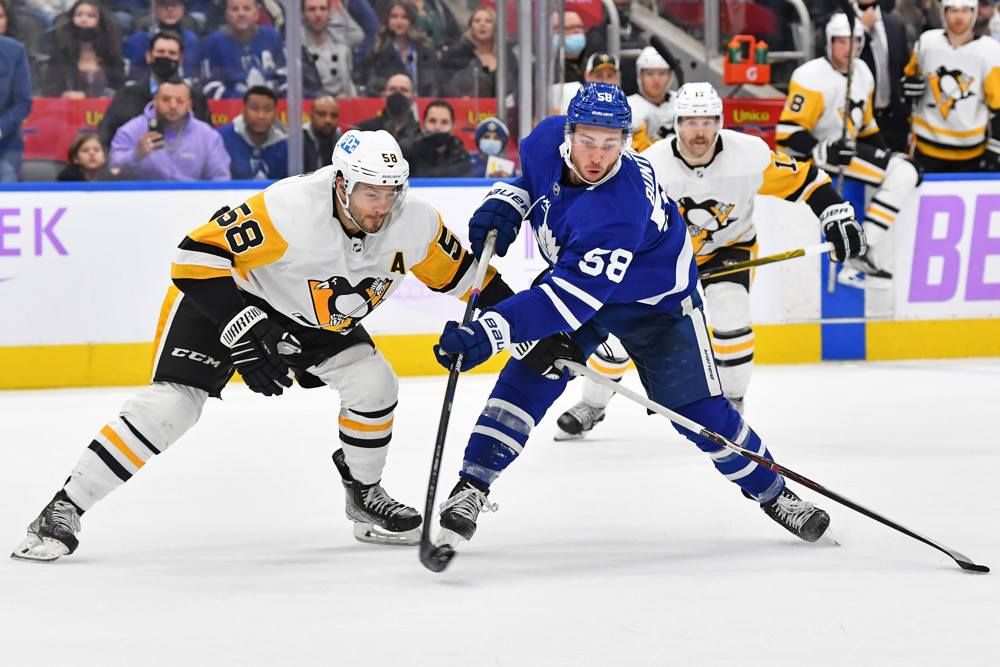Why Michael Bunting Deserves a Long Look on Maple Leafs’ Top Line
Zach Hyman’s journey as a Toronto Maple Leaf was heartwarming. He transformed from a no-name grinder playing out of his depth into a beloved top-six yeoman in the span of a few years. He wasn’t the perfect foil for Auston Matthews, but he filled his role with guts and boundless energy.
When he left the cap-strapped Leafs in free agency, the burning question surrounding Kyle Dubas’ club was who would replace the fan favorite.
For some reason, fellow UFA Nick Ritchie emerged as the top candidate. Maybe it was his draft pedigree (10th overall in 2014). Maybe it was the popular notion that the team needed more size (6’3”, 236 lbs) up front. It certainly couldn’t be his performance. Across his time in Anaheim and Boston, he paced for roughly 30 points per 82 games while providing inconsistent physicality. Moreover, his pitiful work rate would exasperate coaches and infuriate fans. There’s a reason he’s on his third club at age 25.
Through 20 games in Toronto, he’s posted one even-strength point (3 total points) and lost his coveted job twice before the month of December. He ranks 183rd in production out of the 185 forwards who have logged at least 200 minutes at 5-on-5. It isn’t some accident that Matthews (15 points in 17 games) and Mitch Marner (17 points in 20 games) can’t seem to summon their magic next to Ritchie. Plays continually die on his stick:
He barely even attempts to regain possession either:
That’s the guy you want to slot next to the best goal scorer in hockey? It’s almost like management had never seen Ritchie play prior to signing him…and still promised him the first crack next to Matthews and Marner. He can’t keep up with quality forwards and, outside of a few “See, coach?” hits, he doesn’t leverage his strength. He’s routinely outworked in the trenches.
Granted, he has an imposing frame and better hands than your average fourth-liner. But plopping him onto the top unit does every one of its members a disservice. Matthews and Marner are deprived of touches, whereas Ritchie feels compelled to try low-percentage finesse plays.
Thankfully, the Leafs are nevertheless in great shape. They’ve posted a 13-6-1 record without the typically phenomenal output from their superstars.
Better yet, a stronger fit is already on the roster. Bargain-bin signing Michael Bunting (9 points in 20 games) is now enjoying his second chance next to Toronto’s leading lights, and if head coach Sheldon Keefe truly wishes to maximize his top line’s impact, he’ll give the hometown pest a long look in that spot.
While the 26-year-old is 25 pounds lighter than Hyman, he battles his tail off in the dirty areas. Watch how often he manages to get the puck to his more skilled linemates through his hustle and determination:
He does a great job of sealing off his side on the forecheck and funneling the action back toward his teammates. When he has the puck, he understands how to buy time by absorbing contact or spinning away from bodies just long enough for a Leaf to swoop in and extend the attack. Those continuation plays generate waves of offense—and Matthews, in particular, benefits from them because he hasn’t displayed his knack for beating goaltenders cleanly since recovering from offseason wrist surgery. His shooting percentage has plummeted from 18.5 to 9.5.
The more his linemates can feed him, the sooner he’ll work his way out of this funk.
Beyond the forecheck, Bunting can help the top line rediscover its form through his net drive. He looks for tips, offers great screens and claims prime real estate as though his life depends on it. In addition to his effort level, he makes smart decisions in tight, shooting for rebounds or trying to jam pucks in when there isn’t a clear pass available:
There’s a relentlessness to his game that irritates and overwhelms the opposition. By joining a huge market and bringing that same edge on a nightly basis, he’s developed a reputation across the league as a thorn in the side of defensemen.
The numbers don’t lie: No player has drawn penalties at a higher rate this season. Opponents simply don’t like him:
As we know, the most effective agitators can also play a little bit. Though Bunting is primarily a worker bee and disturber, he’s shown flashes of vision and touch that suggest 40-point upside. Obviously, he didn’t carry last season’s ridiculous 26.3 shooting percentage into 2021-22, but he’s still generating opportunities with his limited skill set:
His motor in the corners provides extra touches. His tenacity in front of the net provides space through chaos. His pestiness provides power plays. He isn’t as heavy on the forecheck as Hyman, but he delivers similar traits at a fraction of the cost.
During their shifts together, Matthews and Bunting have averaged 3.56 expected goals and 16.4 high-danger chances per 60 minutes. Matthews and Ritchie have registered a 2.33 xGF60 and 10.7 HDCF60. That’s a massive difference. And with a finisher of Matthews’ caliber, those high-danger metrics are sure to yield actual goals in due course. How long do we expect Matthews’ line to shoot at half of its usual clip?
They’re banging on the door. Keefe can make sure they kick it down by keeping Bunting precisely where he is.
Recent Posts

How Corey Perry Is Making His Presence Felt With the Lightning
View Post »
How Adam Fox Pushed the Rangers Past the Penguins
View Post »

